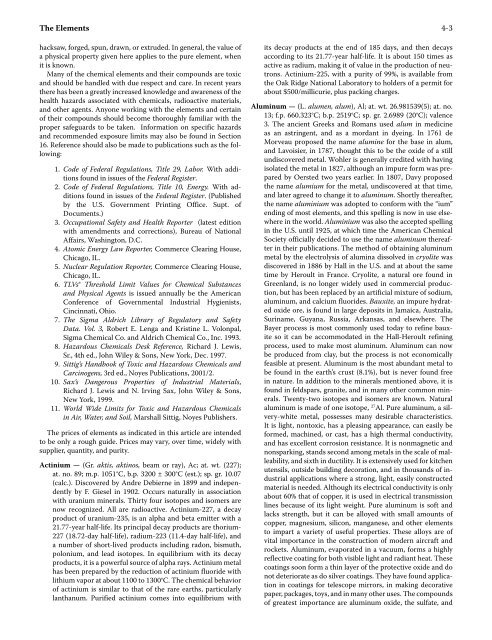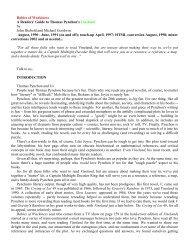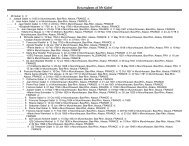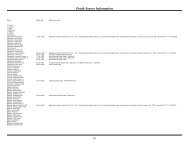CRC Handbook of Chemistry and Physics, 86th Edition
CRC Handbook of Chemistry and Physics, 86th Edition
CRC Handbook of Chemistry and Physics, 86th Edition
Create successful ePaper yourself
Turn your PDF publications into a flip-book with our unique Google optimized e-Paper software.
The Elements 4-3<br />
hacksaw, forged, spun, drawn, or extruded. In general, the value <strong>of</strong><br />
a physical property given here applies to the pure element, when<br />
it is known.<br />
Many <strong>of</strong> the chemical elements <strong>and</strong> their compounds are toxic<br />
<strong>and</strong> should be h<strong>and</strong>led with due respect <strong>and</strong> care. In recent years<br />
there has been a greatly increased knowledge <strong>and</strong> awareness <strong>of</strong> the<br />
health hazards associated with chemicals, radioactive materials,<br />
<strong>and</strong> other agents. Anyone working with the elements <strong>and</strong> certain<br />
<strong>of</strong> their compounds should become thoroughly familiar with the<br />
proper safeguards to be taken. Information on specific hazards<br />
<strong>and</strong> recommended exposure limits may also be found in Section<br />
16. Reference should also be made to publications such as the following:<br />
1. Code <strong>of</strong> Federal Regulations, Title 29, Labor. With additions<br />
found in issues <strong>of</strong> the Federal Register.<br />
2. Code <strong>of</strong> Federal Regulations, Title 10, Energy. With additions<br />
found in issues <strong>of</strong> the Federal Register. (Published<br />
by the U.S. Government Printing Office. Supt. <strong>of</strong><br />
Documents.)<br />
3. Occupational Safety <strong>and</strong> Health Reporter (latest edition<br />
with amendments <strong>and</strong> corrections), Bureau <strong>of</strong> National<br />
Affairs, Washington, D.C.<br />
4. Atomic Energy Law Reporter, Commerce Clearing House,<br />
Chicago, IL.<br />
5. Nuclear Regulation Reporter, Commerce Clearing House,<br />
Chicago, IL.<br />
6. TLVs® Threshold Limit Values for Chemical Substances<br />
<strong>and</strong> Physical Agents is issued annually be the American<br />
Conference <strong>of</strong> Governmental Industrial Hygienists,<br />
Cincinnati, Ohio.<br />
7. The Sigma Aldrich Library <strong>of</strong> Regulatory <strong>and</strong> Safety<br />
Data. Vol. 3, Robert E. Lenga <strong>and</strong> Kristine L. Volonpal,<br />
Sigma Chemical Co. <strong>and</strong> Aldrich Chemical Co., Inc. 1993.<br />
8. Hazardous Chemicals Desk Reference, Richard J. Lewis,<br />
Sr., 4th ed., John Wiley & Sons, New York, Dec. 1997.<br />
9. Sittig’s <strong>H<strong>and</strong>book</strong> <strong>of</strong> Toxic <strong>and</strong> Hazardous Chemicals <strong>and</strong><br />
Carcinogens, 3rd ed., Noyes Publications, 2001/2.<br />
10. Sax’s Dangerous Properties <strong>of</strong> Industrial Materials,<br />
Richard J. Lewis <strong>and</strong> N. Irving Sax, John Wiley & Sons,<br />
New York, 1999.<br />
11. World Wide Limits for Toxic <strong>and</strong> Hazardous Chemicals<br />
in Air, Water, <strong>and</strong> Soil, Marshall Sittig, Noyes Publishers.<br />
The prices <strong>of</strong> elements as indicated in this article are intended<br />
to be only a rough guide. Prices may vary, over time, widely with<br />
supplier, quantity, <strong>and</strong> purity.<br />
Actinium — (Gr. aktis, aktinos, beam or ray), Ac; at. wt. (227);<br />
at. no. 89; m.p. 1051°C, b.p. 3200 ± 300°C (est.); sp. gr. 10.07<br />
(calc.). Discovered by Andre Debierne in 1899 <strong>and</strong> independently<br />
by F. Giesel in 1902. Occurs naturally in association<br />
with uranium minerals. Thirty four isotopes <strong>and</strong> isomers are<br />
now recognized. All are radioactive. Actinium-227, a decay<br />
product <strong>of</strong> uranium-235, is an alpha <strong>and</strong> beta emitter with a<br />
21.77-year half-life. Its principal decay products are thorium-<br />
227 (18.72-day half-life), radium-223 (11.4-day half-life), <strong>and</strong><br />
a number <strong>of</strong> short-lived products including radon, bismuth,<br />
polonium, <strong>and</strong> lead isotopes. In equilibrium with its decay<br />
products, it is a powerful source <strong>of</strong> alpha rays. Actinium metal<br />
has been prepared by the reduction <strong>of</strong> actinium fluoride with<br />
lithium vapor at about 1100 to 1300°C. The chemical behavior<br />
<strong>of</strong> actinium is similar to that <strong>of</strong> the rare earths, particularly<br />
lanthanum. Purified actinium comes into equilibrium with<br />
its decay products at the end <strong>of</strong> 185 days, <strong>and</strong> then decays<br />
according to its 21.77-year half-life. It is about 150 times as<br />
active as radium, making it <strong>of</strong> value in the production <strong>of</strong> neutrons.<br />
Actinium-225, with a purity <strong>of</strong> 99%, is available from<br />
the Oak Ridge National Laboratory to holders <strong>of</strong> a permit for<br />
about $500/millicurie, plus packing charges.<br />
Aluminum — (L. alumen, alum), Al; at. wt. 26.981539(5); at. no.<br />
13; f.p. 660.323°C; b.p. 2519°C; sp. gr. 2.6989 (20°C); valence<br />
3. The ancient Greeks <strong>and</strong> Romans used alum in medicine<br />
as an astringent, <strong>and</strong> as a mordant in dyeing. In 1761 de<br />
Morveau proposed the name alumine for the base in alum,<br />
<strong>and</strong> Lavoisier, in 1787, thought this to be the oxide <strong>of</strong> a still<br />
undiscovered metal. Wohler is generally credited with having<br />
isolated the metal in 1827, although an impure form was prepared<br />
by Oersted two years earlier. In 1807, Davy proposed<br />
the name alumium for the metal, undiscovered at that time,<br />
<strong>and</strong> later agreed to change it to aluminum. Shortly thereafter,<br />
the name aluminium was adopted to conform with the “ium”<br />
ending <strong>of</strong> most elements, <strong>and</strong> this spelling is now in use elsewhere<br />
in the world. Aluminium was also the accepted spelling<br />
in the U.S. until 1925, at which time the American Chemical<br />
Society <strong>of</strong>ficially decided to use the name aluminum thereafter<br />
in their publications. The method <strong>of</strong> obtaining aluminum<br />
metal by the electrolysis <strong>of</strong> alumina dissolved in cryolite was<br />
discovered in 1886 by Hall in the U.S. <strong>and</strong> at about the same<br />
time by Heroult in France. Cryolite, a natural ore found in<br />
Greenl<strong>and</strong>, is no longer widely used in commercial production,<br />
but has been replaced by an artificial mixture <strong>of</strong> sodium,<br />
aluminum, <strong>and</strong> calcium fluorides. Bauxite, an impure hydrated<br />
oxide ore, is found in large deposits in Jamaica, Australia,<br />
Suriname, Guyana, Russia, Arkansas, <strong>and</strong> elsewhere. The<br />
Bayer process is most commonly used today to refine bauxite<br />
so it can be accommodated in the Hall-Heroult refining<br />
process, used to make most aluminum. Aluminum can now<br />
be produced from clay, but the process is not economically<br />
feasible at present. Aluminum is the most abundant metal to<br />
be found in the earth’s crust (8.1%), but is never found free<br />
in nature. In addition to the minerals mentioned above, it is<br />
found in feldspars, granite, <strong>and</strong> in many other common minerals.<br />
Twenty-two isotopes <strong>and</strong> isomers are known. Natural<br />
aluminum is made <strong>of</strong> one isotope, 27 Al. Pure aluminum, a silvery-white<br />
metal, possesses many desirable characteristics.<br />
It is light, nontoxic, has a pleasing appearance, can easily be<br />
formed, machined, or cast, has a high thermal conductivity,<br />
<strong>and</strong> has excellent corrosion resistance. It is nonmagnetic <strong>and</strong><br />
nonsparking, st<strong>and</strong>s second among metals in the scale <strong>of</strong> malleability,<br />
<strong>and</strong> sixth in ductility. It is extensively used for kitchen<br />
utensils, outside building decoration, <strong>and</strong> in thous<strong>and</strong>s <strong>of</strong> industrial<br />
applications where a strong, light, easily constructed<br />
material is needed. Although its electrical conductivity is only<br />
about 60% that <strong>of</strong> copper, it is used in electrical transmission<br />
lines because <strong>of</strong> its light weight. Pure aluminum is s<strong>of</strong>t <strong>and</strong><br />
lacks strength, but it can be alloyed with small amounts <strong>of</strong><br />
copper, magnesium, silicon, manganese, <strong>and</strong> other elements<br />
to impart a variety <strong>of</strong> useful properties. These alloys are <strong>of</strong><br />
vital importance in the construction <strong>of</strong> modern aircraft <strong>and</strong><br />
rockets. Aluminum, evaporated in a vacuum, forms a highly<br />
reflective coating for both visible light <strong>and</strong> radiant heat. These<br />
coatings soon form a thin layer <strong>of</strong> the protective oxide <strong>and</strong> do<br />
not deteriorate as do silver coatings. They have found application<br />
in coatings for telescope mirrors, in making decorative<br />
paper, packages, toys, <strong>and</strong> in many other uses. The compounds<br />
<strong>of</strong> greatest importance are aluminum oxide, the sulfate, <strong>and</strong>







